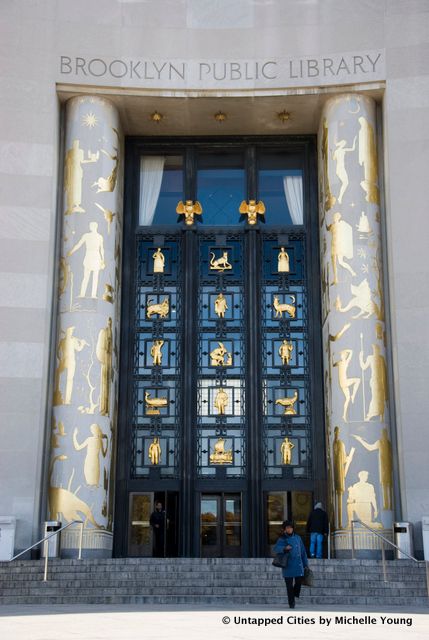Last-Minute NYC Holiday Gift Guide 🎁
We’ve created a holiday gift guide with presents for the intrepid New Yorker that should arrive just in time—



Olmstead and Vaux’s 1865 proposal for Prospect Park in south central Brooklyn provided a cultural community anchor for the expanding borough. The vision for Brooklyn’s Central Park equivalent would include the Brooklyn Museum, Brooklyn Botanical Garden, and the Brooklyn Public Library. The Brooklyn Public Library was prominently placed at the mouth of the great park entrance, and on the ellipse of Grand Army Plaza with its Soldiers’ and Sailors’ Arch. The site location would influence the buildings design and subsequent building campaigns.
Initially proposed in 1888, the publicly financed central library took nearly six decades to build. Ground was broken in 1911 for architect Raymond F. Almiralls’ Beaux-Arts design, but construction would not be completed until 1941. A period of economic instability, Brooklyn Public Library funding contended with the strains of World War I and the Great Depression resulting in changes to Almiralis’ ornate classical design.
In 1935 the architects Alfred Morton Githens and Francis Keally, know for their experience in library design, were commissioned to redesign the building facade while retaining the existing foundations and steel skeleton already in place. Their redesign would simplify and bring a clean geometry to the limestone exterior dominated by vertical pilasters between enormous brass window openings. With the building plan inspired by the leaves of an opened book, the concave limestone “spine” at the main facade follows the curve of Grand Army Plaza. Its massive 50 foot entryway portico is the building’s most monumental feature, illuminating an otherwise spartan facade. Bronze doorways are flanked by two great limestone pylons with Art Deco glyph-like detailing by the German-American sculptor C. Paul Jennewein. Gilded relief carvings depict the enduring themes of science (to the north) and the arts (to the south), including combinations of modern figures of a miner and an electrician, with classical ones, among them Athena and Zeus.
Centered between pylons, the 40 foot bronze gateway displays the work of sculptor Thomas Hudson Jones, and features fifteen bronze panels depicting heroes of American literature, including Herman Melville’s Moby Dick, Mark Twain’s Tom Sawyer, Edgar Allen Poe’s Raven, and Brooklyn’s own Walt Whitman. Above the grid are two gold owls, standing atop small globes with wings outspread. With a series of repairs over time, the entryway is now in need of complete rehabilitation. Funding from Partners in Preservation would replace the doors to exactly resemble the originals while incorporating current energy preservation standards.
The library’s minimal ornament, focused almost entirely on the entry portico, was chosen to express the building’s function as an institution for knowledge and learning. The Githens and Keally design was monumental, modern, and practical, creating a civic building passed by thousands of pedestrians and motorists each day, and a timeless portal for entry to Brooklyn’s Central Public Library serving over one million people per year.
Click here to vote for the Brooklyn Public Library in Partners in Preservation on Twitter and Facebook. Follow Untapped Cities on Twitter and Facebook.
Untapped Cities is an official blog ambassador for Partners in Preservation, a community-based initiative by American Express and the National Trust for Historic Preservation to raise awareness of the importance of historic places. Stay up-to-date with Untapped’s coverage of all 40 sites by following our Partners in Preservation category.
Subscribe to our newsletter